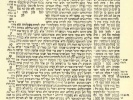
Sacred Texts Judaism Talmud Index Previous Next


Bablyonian Talmud, Book 7: Tract Baba Bathra (Last Gate), tr. by Michael L. Rodkinson, [1918], at sacred-texts.com
APPENDIX TO MISHNA I, CHAP. III., PAGE 83.
WE deem it necessary to call the attention of the reader to the fact that the law of occupancy was chiefly taken from the ancient Roman law 1 about usucapio (occupancy), which dictates that each usucapio without titulius (claim) is not considered. The claims must be pro emptore (purchase) or pro donato (gift), pro legato, pro dote, or pro herede (inheritance); and with usucapio, which is based upon inheritance, no other claim was necessary. The law applied even when it was known that the occupant never had a deed to what he had occupied, and the reason was because the plaintiff had time to protest three years, or at three harvestings, and when he did not make any claim nor any protest, it was evident that the occupant had a right to occupy, and no other evidence was needed. There is also a difference between præsentes and absentes of the occupant. However, concerning servitutes (service) there was also usucapio, in the reverse; namely, pro libertate (liberty), which means that the servant or bondsman had a right to free himself by non usus--namely, when during three years he was never put to any work by his master he became free. But there was no usucapio by using the bondsman, even if for several years: property in him was not acquired if he had no other evidence. (See Ltf. Schweppe, § 305.) According to this, Abraham Krochmal, in his Scholia to the Babylonian Talmud (p. 278) maintains that the term "to slaves" in the Mishna in question means that the law of occupancy applies to these slaves themselves; viz., after three years' rest from any service to their masters, the slaves become free, but not, in accordance with the Gemara, conversely. And so he also explains Resh Lakish's statement (p. 96), "that the law of hazakah does not apply to a living creature," as unchangeable, and it seems to us that so it is.
214:1 The law of occupancy also existed in Persia, but it prescribed no less than twenty years. See text, p. 101.